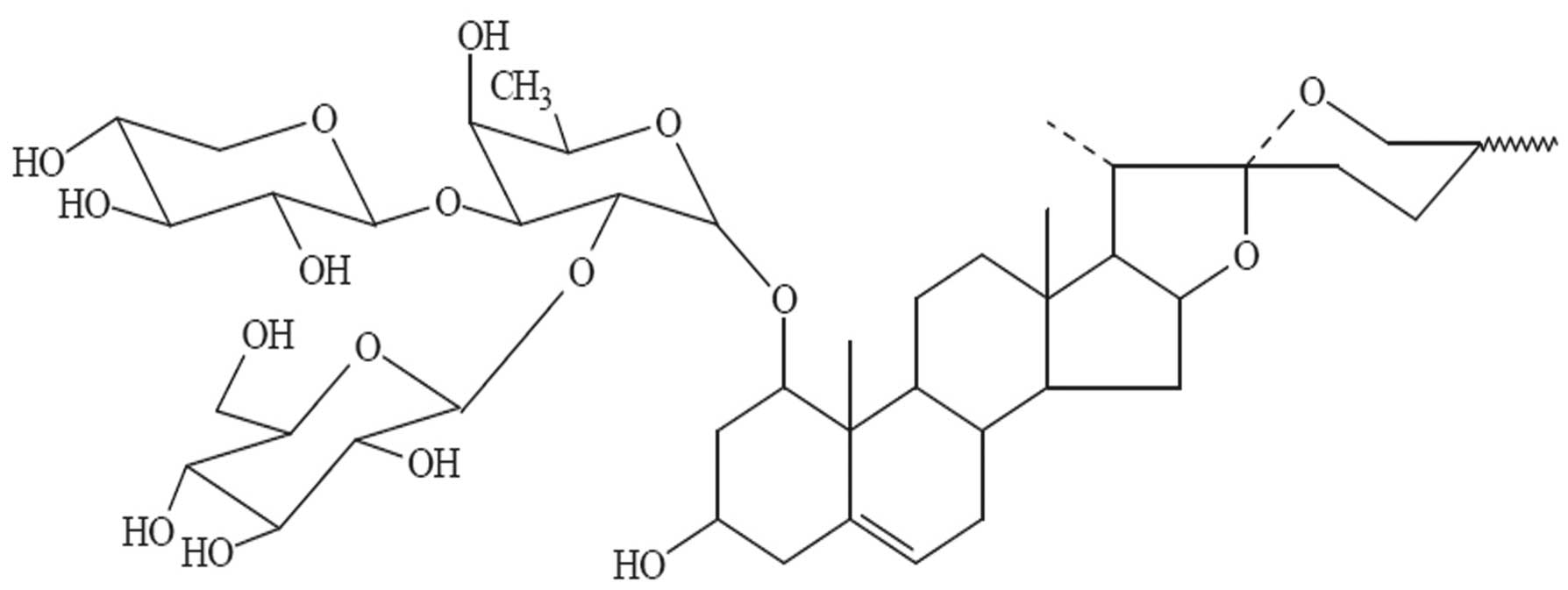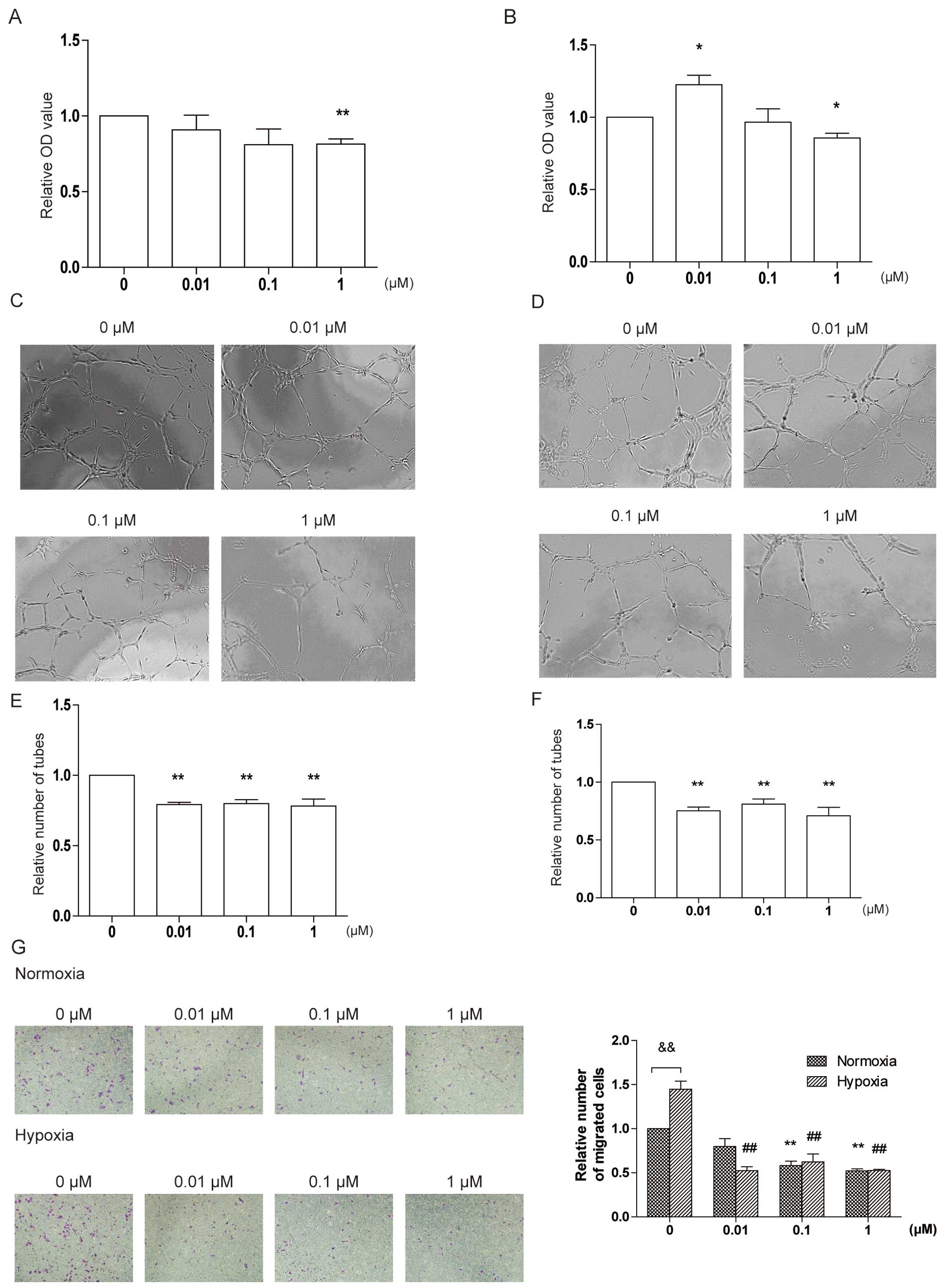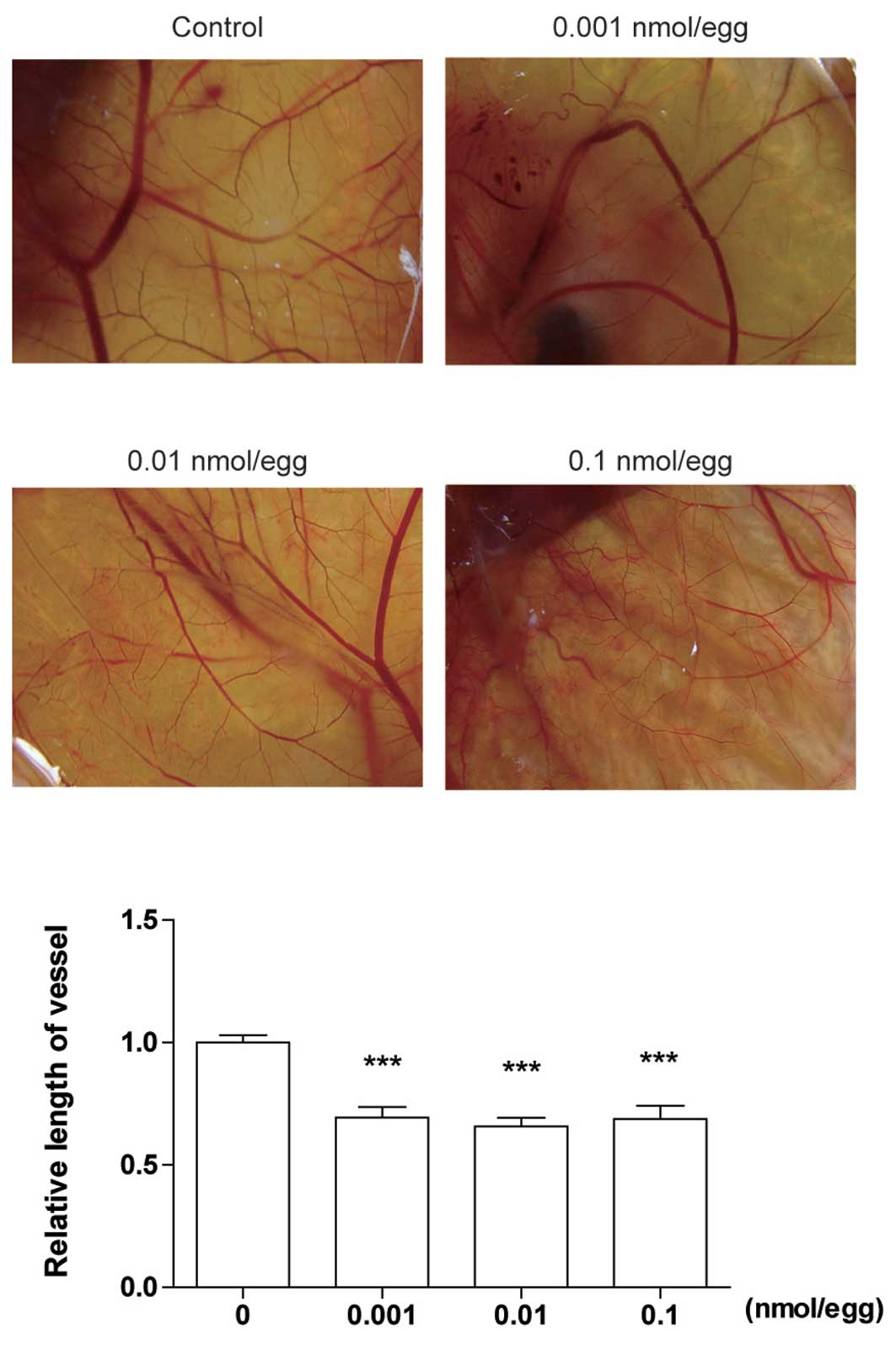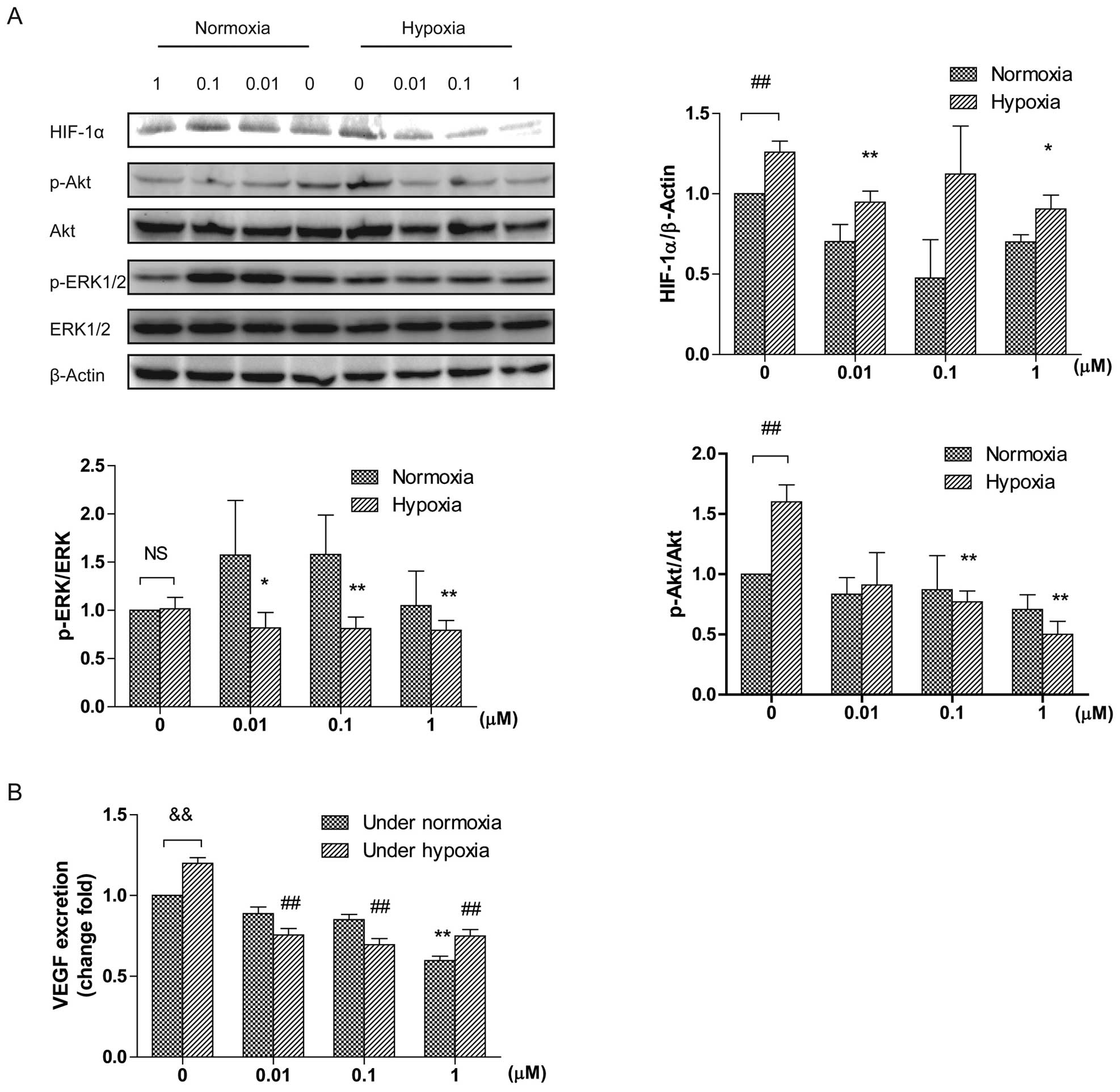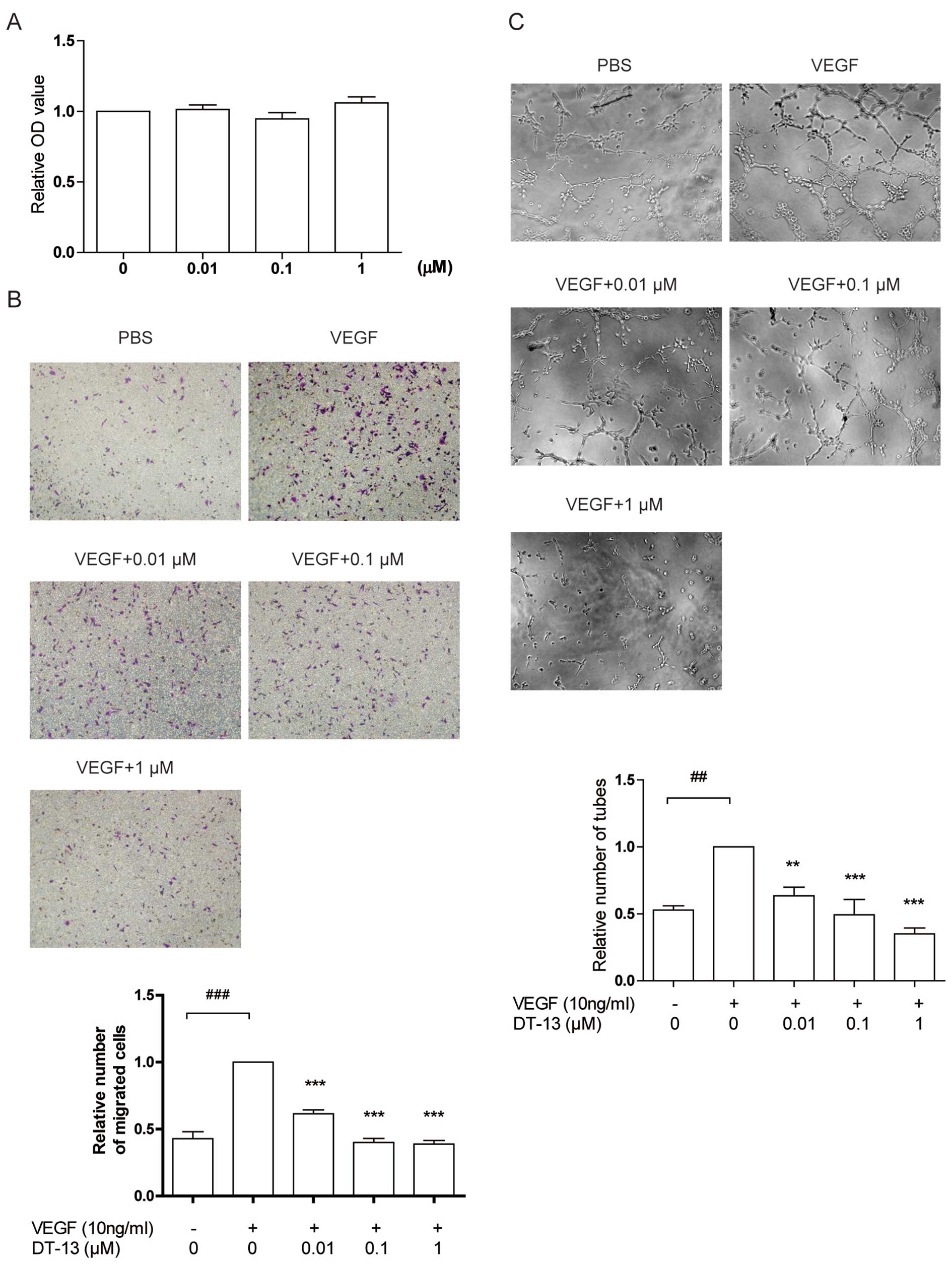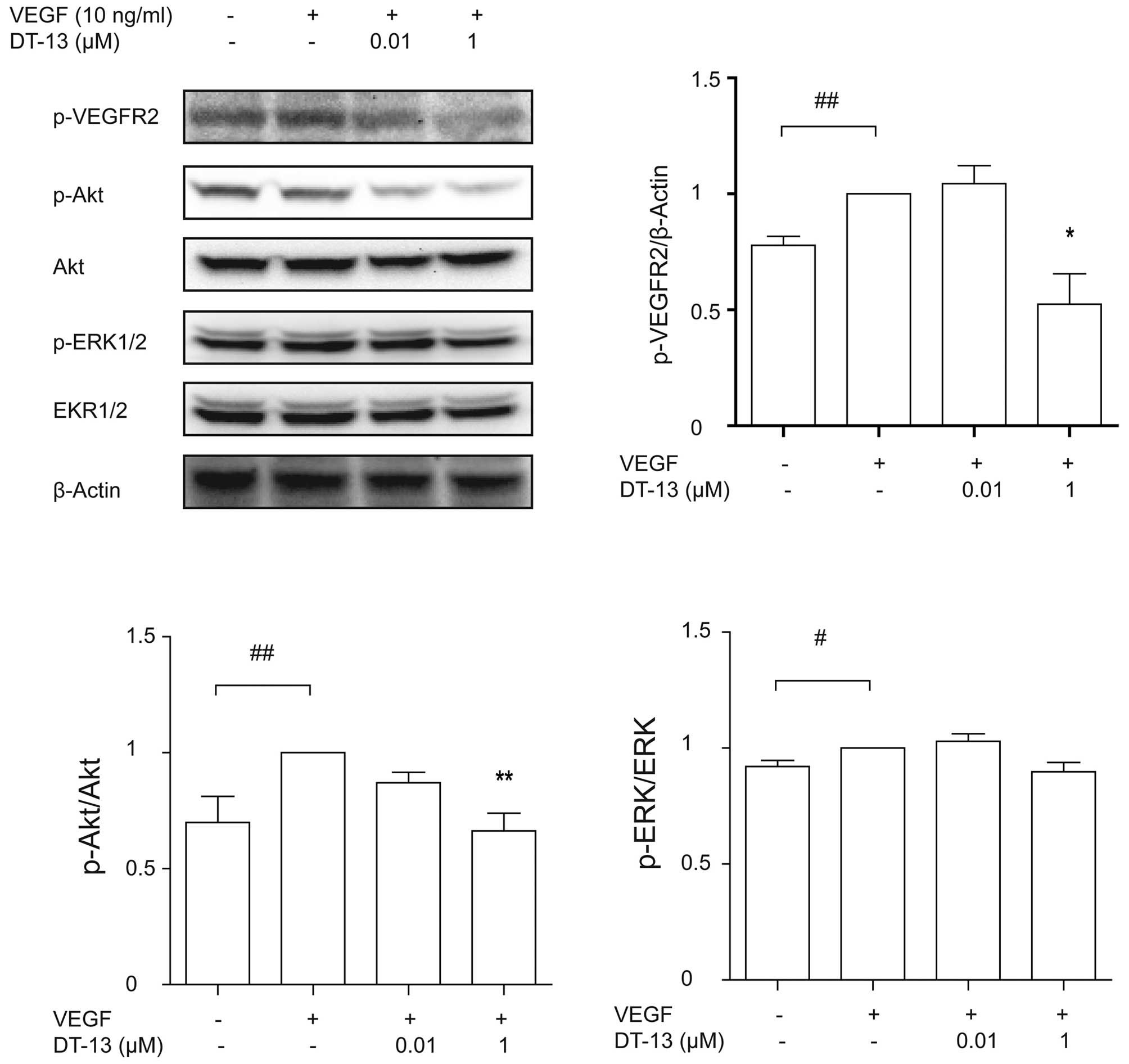The saponin monomer of dwarf lilyturf tuber, DT-13, inhibits angiogenesis under hypoxia and normoxia via multi-targeting activity
- Authors:
- Published online on: February 5, 2013 https://doi.org/10.3892/or.2013.2272
- Pages: 1379-1386
Abstract
Introduction
Aside from tumor cell proliferation, expansion and metastasis, angiogenesis is one of the essential steps in tumor progression. When the diameter is over 0.5 mm, the tumor stimulates blood vessel growth to cover the need for nutrition and oxygen, known as the process of angiogenesis (1). The correlation between angiogenesis and tumor metastasis has been described in two points indicating that angiogenesis plays a key role in tumor metastasis: first, the increased vascularity of the primary tumor always leads to increased number of metastatic colonies; second, increased vascular density is indicative of increased metastasis colony size (2). Thus, anti-angiogenesis is one of the crucial targets of tumor therapy and anti-angiogenic therapy has been used to inhibit cancer growth and metastasis in the clinic (3). For instance, bevacizumab, the first anti-angiogenic drug approved by the FDA, is a monoclonal antibody against vascular endothelial growth factor (VEGF)-A, inhibiting tumor growth and metastasis (4,5) via anti-angiogenesis (6). Various factors induce angiogenesis, including hypoxia. In tumor, due to the accelerated proliferation of tumor resulting in an abnormal and chaotic blood supply, blood vessels cannot provide oxygen adequately or consistently to the whole tumor. Moreover, the temporal changes in blood flow cause endothelium to suffer hypoxia in certain regions (7).
Dwarf lilyturf tuber, a traditional Chinese medicine, is generally used for cardiovascular disease treatment (8). It has been proved that the saponin monomer of dwarf lilyturf tuber, DT-13, exerts anticancer activity (9,10). It has also been reported that some saponin, such as ginseng saponin, could inhibit angiogenesis (11,12). Previous studies on cancer cell lines indicated that DT-13 inhibits MDA-MB-435 cell migration and adhesion. DT-13 downregulates early growth response gene-1 expression resulting in the reduced excretion of tissue factor under hypoxia (13). In addition, DT-13 decreases the excretion and expression of matrix metallopeptidase 2/9 (MMP-2/9) and reduces the phosphorylation of p38 (14). However, the effect of DT-13 on angiogenesis remains unclear. In the present study, we investigated if DT-13 impacts angiogenesis under normoxia or hypoxia and we examined the potential mechanisms.
Materials and methods
Cell culture
Human umbilical vein endothelial cells (HUVECs) were isolated as previously described (15). HUVECs were cultured in complete medium consisting of M199 medium (Gibco), 20% FBS, 50 ng/ml of endothelial cell growth supplement (ECGS, Sigma) and 100 ng/ml heparin. Endothelial cells from third to sixth passages were used for experiments. The cells were incubated in a humidified atmosphere of 95% air, 5% CO2 at 37°C. For hypoxic treatment, we placed 70–80% confluent cells in a tissue culture incubator in an atmosphere of 1% O2 and 5% CO2 at 37°C (16).
HUVEC proliferation assay
HUVECs were harvested, washed with phosphate buffer solution (PBS), re-suspended in complete medium and plated in 96-well plates at the density of 5×103 cells/well, followed by a 12-h incubation. Cells were then treated with 10−8, 10−7 and 10−6 M DT-13 (provided by Professor Bo-Yang Yu) (Fig. 1) for 24 and 48 h under normoxia. The cell viability was evaluated by the Cell Counting kit (CCK-8, Dojindo Laboratories), or the medium was changed to ECGS-free medium (M199 medium with 1% FBS without ECGS). HUVECs were pretreated with 10−8, 10−7 and 10−6 M DT-13 for 1 h, and were then treated with 10 ng/ml VEGF for 48 h. Following treatment, the cell viability was evaluated by the Cell Counting kit.
Cell migration assay
The cell migration assay was performed by using a Transwell chamber migration system with polycarbonate membranes (8.0 μM pore size), as previously described (17). Briefly, HUVECs were harvested, re-suspended in serum-free culture medium and (2×104 cells/well) seeded with various concentrations of DT-13 into the upper chamber. Complete culture medium was added into the lower chamber. The cell migration system was incubated at 37°C for 8 h, or, HUVECs were harvested, re-suspended with ECGS-free medium and plated (2×104 cell/well) in the presence of various concentrations of DT-13 into the upper chamber. VEGF (10 ng/ml) in ECGS-free medium was added into the lower chamber. The cell migration system was incubated at 37°C for 4 h. Following treatment, cells were stained and counted in three randomly selected fields.
Tube formation assay
Tube formation assay was performed as previously described (18). Briefly, 96-well plates were coated with Matrigel (50 μl/well), and incubated at 37°C for 1 h to solidify Matrigel. HUVECs (1.5×104 cells/well) were incubated with various concentrations of DT-13 at 37°C. After 6 h, tubular structures were quantified by manual counting of the number of tubes in three randomly selected fields. When HUVECs were treated with 10 ng/ml of VEGF, the growth factors reduced Matrigel and ECGS-free medium was preferred, and HUVECs were incubated under normoxia. If not, basement Matrigel and complete medium was preferred, and HUVECs were incubated under hypoxia and normoxia.
Chicken embryo chorioallantoic membrane (CAM) assay
A small window was created on the broad side of the 5-day-old egg. The filter paper with different doses of DT-13 (final concentration 0.001, 0.01 and 0.1 nmol/egg) was dropped on the window. The eggs were incubated at 37°C for another 2 days. We then observed the density and length of vessels toward the CAM face and then the CAMs were photographed. Eight eggs were used per group, and the newly formed vessels were counted.
Western blot analysis
Cellular protein extraction and western blot analysis were performed as previously described (16). Briefly, 40 μg total protein was fractionated using 10% sodium dodecyl sulfate polyacrylamide gel electrophoresis (SDS-PAGE) and transferred onto nitrocellulose membranes under semi-dry conditions. Membranes were probed with rabbit anti-human p-extracellular signal-regulated kinase (ERK) 1/2 (CST), ERK1/2 (CST), p-AKT (CST), AKT (CST), HIF-1α (Santa Cruz), and murine anti-human β-actin (Sigma). Horseradish peroxidase (HRP) linked anti-mouse immunoglobulin G (Sigma) and anti-rabbit immunoglobulin G (CST) were used as the secondary antibodies. Protein bands were visualized by enhanced chemiluminescence reagents (Amersham Pharmacia Biotech).
Enzyme-linked immunosorbent assay (ELISA)
HUVECs were plated into 60-mm dishes with completed medium overnight. HUVECs were changed medium to serum and growth factor supplement-free medium. After 2 h, cells were treated with various concentrations of DT-13 for 12 h under hypoxia or normoxia. After treatment, the medium was harvested to detect the concentration of VEGF by ELISA. The level of VEGF in HUVEC medium was measured with a VEGF ELISA kit (4A Biotech) according to the manufacturer’s protocol.
Statistical analysis
The data represent at least three independent experiments and are expressed as the means ± SEM. For statistical analysis, the Student’s t-test was used as appropriate.
Results
Effect of DT-13 on HUVEC proliferation
To identify the cytotoxicity of DT-13, we treated HUVECs with 0.01, 0.1 and 1 μM DT-13 for 24 and 48 h. DT-13 at 1 μM inhibited cell proliferation to 71 and 86% of control at 24 and 48 h of treatment, respectively (Fig. 2A and B). However, 0.01 μM of DT-13 slightly improved HUVEC proliferation after 48 h of treatment. These results indicate that DT-13 inhibits HUVEC proliferation at high concentrations but promotes proliferation at low concentrations.
DT-13 inhibits tube formation and HUVEC migration under hypoxia and normoxia
To further investigate the effect of DT-13 on angiogenesis, we performed tube formation and migration assays under normoxic and hypoxic conditions, since DT-13 displayed marked anticancer activity under hypoxia (13). In the tube formation study, HUVECs were treated with 0.01, 0.1 and 1 μM DT-13 and incubated under normoxia or hypoxia for 6 h. Under normoxia, different concentrations of DT-13 showed similar inhibitory effects on tube formation by 20% compared with control (21, 20 and 21% by 0.01, 0.1 and 1 μM of DT-13 respectively) (Fig. 2C and E). Under hypoxia, the inhibitory activity was 25, 19 and 29% compared with control, respectively (Fig. 2D and F).
In the migration assay, we planted HUVECs into the upper chamber of Transwell with serum-free medium in the presence or absence of DT-13, and added complete medium into the lower chamber. Under normoxia, DT-13 reduced the number of migrated cells with the inhibitory rate of 20, 40 and 48% at the concentration of 0.01, 0.1 and 1 μM, respectively (Fig. 2G). Under hypoxia, DT-13 performed stronger activity on inhibiting migration; different concentrations of DT-13 showed similar inhibitory effects on migration by 40% compared with control (36, 43 and 36% by 0.01, 0.1 and 1 μM of DT-13 respectively) (Fig. 2G). These results indicate that DT-13 inhibits tube formation and migration under normoxia and this effect is stronger under hypoxia.
DT-13 inhibits angiogenesis in vivo
To confirm the anti-angiogenesis activity of DT-13 in vivo, we used a CAM model. Five-day-old eggs were treated with PBS or DT-13 (0.1, 0.01 and 0.001 nmol/egg) for 48 h under normoxia. The normal branching pattern of blood vessels formed after 2 days of incubation. As shown in Fig. 3, DT-13 significantly reduced the relative length of vessels. Different concentrations of DT-13 showed similar inhibitory rates approximately 35% compared with PBS. These data suggest that DT-13 inhibits angiogenesis in vivo with a large spectrum of dose.
DT-13 downregulates the level of HIF-1α, p-ERK, and p-Akt under hypoxia
Hypoxia-inducible factor 1α (HIF-1α) accumulates under hypoxia and is a crucial factor for angiogenesis (19). Thus, we investigated if DT-13 affects the level of HIF-1α. Hypoxia strongly upregulated HIF-1α expression compared with normoxia (Fig. 4A). However, DT-13 decreased the amount of HIF-1α both under normoxia and hypoxia. Under hypoxia, DT-13 at the concentrations of 0.01 and 1 μM significantly downregulated increased HIF-1α induced by hypoxia. Moreover, DT-13 significantly downregulated ERK1/2 and Akt phosphorylation in a dose-dependent manner under hypoxia (Fig. 4A). Under normoxia, DT-13 only slightly reduced the level of p-Akt at 1 μM (Fig. 4A). These data suggest that DT-13 exerts anti-angiogenic effects under hypoxia by inhibiting ERK1/2 and Akt phosphorylation.
DT-13 inhibits VEGF excretion under hypoxia
We also detected whether DT-13 impacts VEGF secretion under normoxia and hypoxia with the ELISA assay. The medium of HUVECs was changed to serum-free medium and incubated with or without DT-13 under normoxia or hypoxia for 12 h. The conditioned medium was collected and examined. As shown in Fig. 4B, under normoxia DT-13 decreased VEGF secretion in a dose-dependent manner with the inhibition rate of 11, 15 and 40% by 0.01, 0.1 and 1 μM of DT-13. Under hypoxia, DT-13 always showed similar inhibitory rates by 40% compared with control (37, 42 and 38% by 0.01, 0.1 and 1 μM of DT-13 respectively) (Fig. 4B).
DT-13 inhibits angiogenesis induced by VEGF
As shown above, DT-13 exhibited anti-angiogenic ability and inhibited VEGF excretion under normoxia and hypoxia, thus we investigated whether DT-13 inhibits angiogenesis induced by VEGF. Initially, DT-13 did not inhibit cell proliferation at the presence of VEGF within 48 h (Fig. 5A). However, DT-13 exhibited anti-angiogenic effects observed from cell migration and tube formation assays. DT-13 reduced the number of migrated cells induced by VEGF with the inhibitory rate of 61.5, 40.1 and 38.9% at the concentration of 0.01, 0.1 and 1 μM respectively (Fig. 5B), and decreased tube formation to 63.4, 49.3 and 35% of control at the concentration of 0.01, 0.1 and 1 μM (Fig. 5C). The results indicate that DT-13 attenuates the effect of VEGF on angiogenesis by inhibiting HUVEC migration and tube formation, but does not affect HUVEC proliferation induced by VEGF.
DT-13 exhibits anti-angiogenic activity by inhibiting the VEGF pathway
As shown above, angiogenesis induced by VEGF is weakened by DT-13. Therefore, we evaluated if DT-13 affects the downstream of VEGF pathway. Firstly, we detected the phosphorylation of VEGFR2, the receptor of VEGF. We pretreated HUVECs with or without DT-13 for 1 h and then treated with 10 ng/ml VEGF for 15 min. VEGF significantly promoted the phosphorylation of VEGFR2 compared with PBS, while DT-13 decreased the level of p-VEGFR2 induced by VEGF, with a significant difference at the concentration of 1 μM (Fig. 6). Furthermore, we examined the phosphorylation of Akt and ERK1/2 after VEGF and DT-13 treatment. VEGF increased the level of p-Akt, which was markedly attenuated by 1 μM DT-13 (Fig. 6). However, increased p-ERK1/2 was slightly decreased by DT-13 without statistical difference (Fig. 6). These results suggest that under hypoxia, DT-13 inhibits angiogenesis by inhibiting the VEGF pathway.
Discussion
In this study, we demonstrated that DT-13 exhibits anti-angiogenic activity under hypoxia and normoxia, and inhibits angiogenesis induced by VEGF under normoxia in vitro. DT-13 administration resulted in a significant reduction of HUVEC proliferation, migration and tube formation under hypoxia and normoxia. Further evaluation with CAM likely results in reduced relative vessel length in DT-13-treated eggs. To address the potential mechanism of the anti-angiogenic effects of DT-13, we detected the elements involved in angiogenesis, such as HIF-1α, p-Akt, and ERK1/2 which showed significantly decreased levels after DT-13 treatment under hypoxia but not under normoxia. Additionally, DT-13 reduced VEGF secretion and VEGF induced p-VEGFR2 and p-Akt. These findings indicate a role for DT-13 in the inhibition of angiogenesis under hypoxia and normoxia or even of angiogenesis induced by VEGF.
At present, there are three types of anti-angiogenesis drugs: antibody, synthetic small molecules, and natural products (20). Although the effects of the anti-VEGF-A antibody, bevacizumab, have been confirmed in clinical anti-angiogenic therapy combined with a cytotoxic agent (21), there are still adverse effects in the cardiovascular and renal systems (22,23). Multiple-target small molecules and natural products performed anti-angiogenic activity, such as sorafenib and curcumin (20). Previous studies on cancer cells suggested that DT-13 exhibits anticancer activity via inhibiting cancer cell migration and adhesion in vitro(13,14). Our data showed that DT-13 displays anti-angiogenic activity by inhibiting tube formation and HUVEC migration. Endothelial cells in tumor are under two main oxygen conditions, normoxia and hypoxia. Endothelial cells are under hypoxia during the pathological state, such as atherosclerosis and cancer (19,24–26). Hypoxic conditions stimulate the expression of pro-angiogenic protein, such as VEGF and its receptor VEGFR2, in endothelial cells (27–29). VEGFR-2 plays a crucial role in angiogenesis and activation of VEGFR-2 promotes endothelial cell growth, migration and tube formation (30). In VEGFR-2-deficient mice, failed formation of blood islands and blood vessels led to embryonic lethality (31), which indicates that VEGFR-2 is essential in angiogenesis. Stimulation of VEGFR-2 phosphorylates downstreams, such as ERK1/2 (32) and Akt (33). DT-13 reduces the level of p-Akt and ERK1/2 under hypoxia and p-VEGFR-2 and p-Akt induced by VEGF under normoxia, but displays little effect on p-ERK1/2 induced by VEGF. DT-13 displays higher activity of inhibition on p-Akt and p-ERK1/2 under hypoxia than under normoxia. Furthermore, DT-13 reduces the increased HIF-1α induced by hypoxia, which may also reduce angiogenesis considering the role of HIF-1α in angiogenesis (19). Thus, DT-13 could be a new multi-targeting anticancer agent by inhibiting angiogenesis, tumor growth and metastasis.
In conclusion, we provided evidence for the first time that DT-13 exhibits anti-angiogenic activity. Further animal studies are required to confirm the effect of DT-13 on angiogenesis and to explore the side-effects of DT-13.
Acknowledgements
This study was financially supported by the National Natural Science Fund Nos. 81102853 and 81071841, and 2011’ Program for Excellent Scientific and Technological Innovation Team of Jiangsu Higher Education.
References
|
Bamias A and Dimopoulos MA: Angiogenesis in human cancer: implications in cancer therapy. Eur J Intern Med. 14:459–469. 2003. View Article : Google Scholar : PubMed/NCBI | |
|
Zetter BR: Angiogenesis and tumor metastasis. Annu Rev Med. 49:407–424. 1998. View Article : Google Scholar : PubMed/NCBI | |
|
He K, Jin K, Wang H and Teng L: Anti-angiogenic therapy for colorectal cancer: on the way to getting better! Hepatogastroenterology. 59:1113–1117. 2012.PubMed/NCBI | |
|
Das M and Wakelee H: Targeting VEGF in lung cancer. Expert Opin Ther Targets. 16:395–406. 2012. View Article : Google Scholar | |
|
Teghom C, Giraud P, Menei P, et al: Renal carcinoma: point on treatment of brain metastasis. Bull Cancer. 99:627–634. 2012.(In French). | |
|
Wicki A and Rochlitz C: Targeted therapies in breast cancer. Swiss Med Wkly. 142:w135502012. | |
|
Dachs GU and Tozer GM: Hypoxia modulated gene expression: angiogenesis, metastasis and therapeutic exploitation. Eur J Cancer. 36:1649–1660. 2000. View Article : Google Scholar : PubMed/NCBI | |
|
Fang XC and Yu BY: Application of pyrolysis-high-resolution gas chromatography-pattern recognition to the identification of the Chinese traditional medicine mai dong. J Chromatogr. 514:287–292. 1990. View Article : Google Scholar : PubMed/NCBI | |
|
Yang PMAX: The initial research on Hupeh Liriope Root Tuber inducing HL60 cell differentiation. Dalian Med College J. 14:37–41. 1992. | |
|
Mimaki Y, Takaashi Y, Kuroda M, Sashida Y and Nikaido T: Steroidal saponins from Nolina recurvata stems and their inhibitory activity on cyclic AMP phosphodiesterase. Phytochemistry. 42:1609–1615. 1996. | |
|
Jeong A, Lee HJ, Jeong SJ, Lee EO, Bae H and Kim SH: Compound K inhibits basic fibroblast growth factor-induced angiogenesis via regulation of p38 mitogen activated protein kinase and AKT in human umbilical vein endothelial cells. Biol Pharm Bull. 33:945–950. 2010. View Article : Google Scholar | |
|
Tong Y, Zhang X, Tian F, et al: Philinopside A, a novel marine-derived compound possessing dual anti-angiogenic and anti-tumor effects. Int J Cancer. 114:843–853. 2005. View Article : Google Scholar : PubMed/NCBI | |
|
Sun L, Lin S, Zhao R, Yu B, Yuan S and Zhang L: The saponin monomer of dwarf lilyturf tuber, DT-13, reduces human breast cancer cell adhesion and migration during hypoxia via regulation of tissue factor. Biol Pharm Bull. 33:1192–1198. 2010. View Article : Google Scholar : PubMed/NCBI | |
|
Zhang Y, Liu J, Kou J, Yu J and Yu B: DT-13 suppresses MDA-MB-435 cell adhesion and invasion by inhibiting MMP-2/9 via the p38 MAPK pathway. Mol Med Rep. 6:1121–1125. 2012.PubMed/NCBI | |
|
Jaffe EANR, Becker CG and Minick CR: Culture of human endothelial cells derived from umbilical veins. Identification by morphologic and immunologic criteria. J Clin Invest. 52:2745–2756. 1973. View Article : Google Scholar : PubMed/NCBI | |
|
Lin S, Sun L, Hu J, et al: Chemokine C-X-C motif receptor 6 contributes to cell migration during hypoxia. Cancer Lett. 279:108–117. 2009. View Article : Google Scholar : PubMed/NCBI | |
|
Lee OH, Kim YM, Lee YM, et al: Sphingosine 1-phosphate induces angiogenesis: its angiogenic action and signaling mechanism in human umbilical vein endothelial cells. Biochem Biophys Res Commun. 264:743–750. 1999. View Article : Google Scholar : PubMed/NCBI | |
|
Ashton AW, Yokota R, John G, et al: Inhibition of endothelial cell migration, intercellular communication, and vascular tube formation by thromboxane A(2). J Biol Chem. 274:35562–35570. 1999. View Article : Google Scholar : PubMed/NCBI | |
|
Chen L, Endler A and Shibasaki F: Hypoxia and angiogenesis: regulation of hypoxia-inducible factors via novel binding factors. Exp Mol Med. 41:849–857. 2009. View Article : Google Scholar : PubMed/NCBI | |
|
Wahl O, Oswald M, Tretzel L, Herres E, Arend J and Efferth T: Inhibition of tumor angiogenesis by antibodies, synthetic small molecules and natural products. Curr Med Chem. 18:3136–3155. 2011. View Article : Google Scholar | |
|
Ma J and Waxman DJ: Combination of antiangiogenesis with chemotherapy for more effective cancer treatment. Mol Cancer Ther. 7:3670–3684. 2008. View Article : Google Scholar : PubMed/NCBI | |
|
Higa GM and Abraham J: Biological mechanisms of bevacizumab-associated adverse events. Expert Rev Anticancer Ther. 9:999–1007. 2009. View Article : Google Scholar : PubMed/NCBI | |
|
Chen HX and Cleck JN: Adverse effects of anticancer agents that target the VEGF pathway. Nat Rev Clin Oncol. 6:465–477. 2009. View Article : Google Scholar : PubMed/NCBI | |
|
Chakrabarti S, Rizvi M, Pathak D, Kirber MT and Freedman JE: Hypoxia influences CD40-CD40L mediated inflammation in endothelial and monocytic cells. Immunol Lett. 122:170–184. 2009. View Article : Google Scholar : PubMed/NCBI | |
|
Sluimer JC and Daemen MJ: Novel concepts in atherogenesis: angiogenesis and hypoxia in atherosclerosis. J Pathol. 218:7–29. 2009. View Article : Google Scholar : PubMed/NCBI | |
|
Izzard AS, Emerson M, Prehar S, et al: The cardiovascular phenotype of a mouse model of acromegaly. Growth Horm IGF Res. 19:413–419. 2009. View Article : Google Scholar : PubMed/NCBI | |
|
Verlohren S, Stepan H and Dechend R: Angiogenic growth factors in the diagnosis and prediction of pre-eclampsia. Clin Sci. 122:43–52. 2012. View Article : Google Scholar : PubMed/NCBI | |
|
Nagamatsu T, Fujii T, Kusumi M, et al: Cytotrophoblasts up-regulate soluble fms-like tyrosine kinase-1 expression under reduced oxygen: an implication for the placental vascular development and the pathophysiology of preeclampsia. Endocrinology. 145:4838–4845. 2004. View Article : Google Scholar : PubMed/NCBI | |
|
Forsythe JA, Jiang BH, Iyer NV, et al: Activation of vascular endothelial growth factor gene transcription by hypoxia-inducible factor 1. Mol Cell Biol. 16:4604–4613. 1996.PubMed/NCBI | |
|
Takahashi S: Vascular endothelial growth factor (VEGF), VEGF receptors and their inhibitors for antiangiogenic tumor therapy. Biol Pharm Bull. 34:1785–1788. 2011. View Article : Google Scholar : PubMed/NCBI | |
|
Shalaby F, Rossant J, Yamaguchi TP, et al: Failure of blood-island formation and vasculogenesis in Flk-1-deficient mice. Nature. 376:62–66. 1995. View Article : Google Scholar : PubMed/NCBI | |
|
Zachary I and Gliki G: Signaling transduction mechanisms mediating biological actions of the vascular endothelial growth factor family. Cardiovasc Res. 49:568–581. 2001. View Article : Google Scholar | |
|
Gerber HP, McMurtrey A, Kowalski J, et al: Vascular endothelial growth factor regulates endothelial cell survival through the phosphatidylinositol 3′-kinase/Akt signal transduction pathway. Requirement for Flk-1/KDR activation. J Biol Chem. 273:30336–30343. 1998. |



